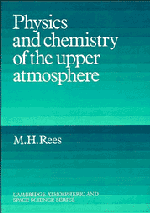Book contents
- Frontmatter
- Contents
- Preface
- Acknowledgements
- 1 An overview
- 2 The interaction of energetic solar photons with the upper atmosphere
- 3 The interaction of energetic electrons and ions with the upper atmosphere
- 4 Collisions and reactions
- 5 Ion and neutral composition of the upper atmosphere
- 6 Temperatures in the upper atmosphere
- 7 Spectroscopic emissions
- 8 Dynamics of the thermosphere and ionosphere
- Appendices
- Index
8 - Dynamics of the thermosphere and ionosphere
Published online by Cambridge University Press: 04 April 2011
- Frontmatter
- Contents
- Preface
- Acknowledgements
- 1 An overview
- 2 The interaction of energetic solar photons with the upper atmosphere
- 3 The interaction of energetic electrons and ions with the upper atmosphere
- 4 Collisions and reactions
- 5 Ion and neutral composition of the upper atmosphere
- 6 Temperatures in the upper atmosphere
- 7 Spectroscopic emissions
- 8 Dynamics of the thermosphere and ionosphere
- Appendices
- Index
Summary
Introduction
Discussion of the dynamic behaviour of the thermosphere and ionosphere has been left for the last chapter for several reasons. The phenomenology is complex. The global scale wind pattern shows little geographic symmetry, being influenced by the seasonal variability over the globe of the input of solar energy and by geomagnetically controlled ion drift. Since momentum and energy sources vary non-uniformly with altitude, the dynamic response likewise has height-dependent structure. Superimposed on the quasi-steady winds and drifts there are waves that may be generated within the thermosphere or propagate from below. The perturbations may be systematic, such as tidal effects, or impulsive, such as auroral storms. The goal is to understand the large scale or global dynamics as well as the small scale or localized perturbations. The dynamic behaviour of the thermosphere and ionosphere cannot be fully understood without knowledge of the structure and energetics of the region. These properties, presented in the preceding chapters, are therefore incorporated as required.
The system is three-dimensional and time-dependent and there exists a wide range of scale lengths and time constants. Predicting the temporal and spatial morphology of the observable parameters that characterize the thermosphere and ionosphere provides a continuing challenge. As this chapter is being written, a fully self-consistent analysis of the coupled ionosphere and thermosphere is a topic that is at the cutting edge of upper atmosphere research.
- Type
- Chapter
- Information
- Physics and Chemistry of the Upper Atmosphere , pp. 186 - 242Publisher: Cambridge University PressPrint publication year: 1989

